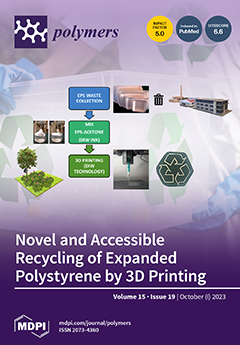Chitosan and its derivatives are widely used in food packaging, pharmaceutical, biotechnology, medical, textile, paper, agriculture, and environmental industries. However, the flexibility of chitosan films is extremely poor, which limits its relevant applications to a large extent. In this paper, chitosan/sorbitol/nano-silica (CS/sorbitol/SiO
2
[...] Read more.
Chitosan and its derivatives are widely used in food packaging, pharmaceutical, biotechnology, medical, textile, paper, agriculture, and environmental industries. However, the flexibility of chitosan films is extremely poor, which limits its relevant applications to a large extent. In this paper, chitosan/sorbitol/nano-silica (CS/sorbitol/SiO
2) composite films were prepared by the casting film method using chitosan, sorbitol, Tween-80 and nano-SiO
2 as raw materials. The structure of the films was characterized by infrared spectroscopy, electron scanning microscopy, and X-ray diffraction analysis. The effects of sorbitol and nano-silica dosage on the mechanical properties, thermal properties and water vapor barrier properties of the composite film were investigated. The results show that with the gradual increase in sorbitol (≤75 wt %), the elongation at the break of chitosan/sorbitol films significantly increased. When the addition of sorbitol was 75 wt %, the elongation at break of the chitosan/sorbitol composite film was 13 times higher than that of the chitosan film. Moreover, nano-SiO
2 can further improve the mechanical properties and thermal stability of the chitosan/sorbitol composite films. When the amount of nano-silica was 4.5 wt %, the composite film became more flexible, with a maximum elongation of 90.8% (which is 14 times that of chitosan film), and its toughness increased to 10.52 MJm
−3 (which is 6 times that of chitosan film). This study balances the tensile strength and elongation at break of the composite films by adding a plasticizer and nano-filler, providing a reference for the preparation of chitosan composites or their blending with other polymers, and has practical guiding significance for the industrial production of biomass plastics.
Full article






